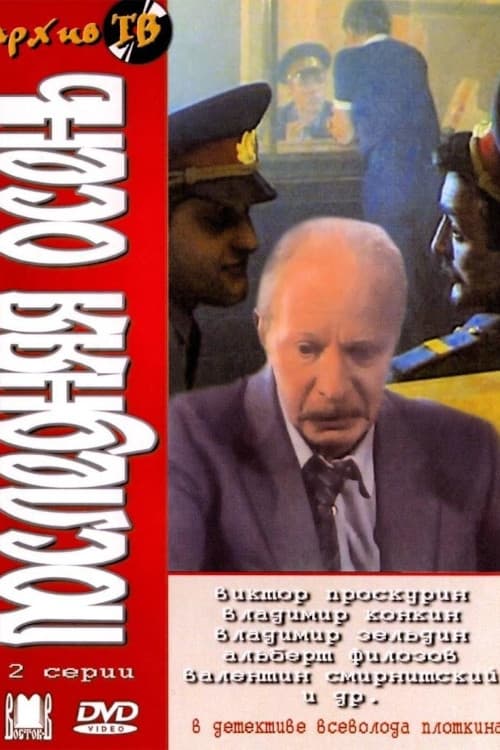
Ask Your Own Question
What is the plot?
What is the ending?
In the ending of "Poslednyaya Osen," the main character, a teacher named Anna, faces the consequences of her choices as she grapples with her feelings for a former student, Andrei. The film concludes with Anna making a significant decision about her future, ultimately leading to a poignant farewell.
As the final scenes unfold, Anna is seen walking through the autumn landscape, reflecting on her life and the relationships she has formed. The emotional weight of her past decisions hangs heavily in the air. The film closes with a sense of unresolved tension, leaving the audience to ponder the implications of love, loss, and the passage of time.
As the film approaches its conclusion, the atmosphere is thick with the golden hues of autumn, the leaves swirling around Anna as she walks through the park. The camera captures her contemplative expression, revealing the internal struggle she has faced throughout the story. She is a teacher who has dedicated her life to her students, yet her heart has been pulled in a different direction by her feelings for Andrei, a former student who has now become a man of his own.
In the preceding scenes, Anna has been confronted by the reality of her emotions. She has spent time with Andrei, reminiscing about their past and the bond they shared. However, the weight of societal expectations and her own fears about crossing the boundaries of their relationship loom large. The tension between them is palpable, filled with unspoken words and lingering glances.
As the sun begins to set, casting a warm glow over the landscape, Anna finds herself at a crossroads. She meets Andrei one last time, and their conversation is charged with emotion. They discuss their dreams and the paths they have chosen, both aware that their lives may never intertwine in the same way again. Anna's voice trembles as she expresses her fears of what could happen if they were to pursue a deeper connection. Andrei, with a mixture of understanding and longing, reassures her that their bond will always remain, regardless of the choices they make.
In a moment of clarity, Anna realizes that she must let go of the past to embrace her future. She takes a deep breath, her heart heavy yet resolute, and tells Andrei that she cannot hold onto the hope of what might have been. The decision is painful, but it is also liberating. As she walks away, the camera lingers on Andrei's face, capturing the sadness and acceptance in his eyes.
The final scene shows Anna walking alone through the park, the leaves crunching beneath her feet. The beauty of the autumn landscape contrasts with the bittersweet nature of her farewell. She looks back one last time, a mixture of sorrow and gratitude etched on her face. The film fades to black, leaving the audience with a lingering sense of loss and the understanding that life moves forward, even when we must leave certain things behind.
In the end, Anna chooses to prioritize her own growth and the responsibilities she has as a teacher, while Andrei is left to navigate his own path, forever changed by their connection. The film closes on a note of reflection, emphasizing the complexities of love and the inevitability of change.
Is there a post-credit scene?
The movie "Poslednyaya Osen," produced in 1990, does not feature a post-credit scene. The film concludes its narrative without any additional scenes or content after the credits roll. The story wraps up with a poignant resolution, focusing on the emotional and thematic elements established throughout the film, leaving the audience to reflect on the characters' journeys and the overarching themes of love, loss, and the passage of time.
What internal conflicts does the protagonist face throughout the film?
The protagonist grapples with feelings of inadequacy and the pressure to conform to societal expectations. This internal struggle is depicted through moments of introspection and emotional turmoil, as they seek to reconcile personal desires with familial obligations, ultimately leading to a poignant journey of self-discovery.
What is the significance of the main character's relationship with their family in Poslednyaya Osen?
The main character's relationship with their family is central to the narrative, showcasing the emotional struggles and the weight of familial expectations. As the protagonist navigates personal challenges, their interactions with family members reveal deep-seated conflicts and a longing for connection, highlighting the complexities of love and duty.
How does the setting influence the events in Poslednyaya Osen?
The setting of Poslednyaya Osen, with its autumnal backdrop, serves as a metaphor for change and transition. The visual imagery of falling leaves and the encroaching chill of winter parallels the characters' emotional states, emphasizing themes of loss and the passage of time, which are pivotal to the unfolding drama.
How do secondary characters contribute to the main character's development in Poslednyaya Osen?
Secondary characters play crucial roles in shaping the protagonist's journey. Each character embodies different aspects of societal norms and personal aspirations, challenging the protagonist's views and pushing them towards growth. Their interactions often serve as catalysts for pivotal moments of realization and change.
What role does nature play in the character's emotional journey in Poslednyaya Osen?
Nature is intricately woven into the emotional landscape of Poslednyaya Osen. The changing seasons reflect the protagonist's inner turmoil and growth, with autumn symbolizing both decay and the beauty of transformation. Scenes set in natural surroundings evoke feelings of nostalgia and contemplation, enhancing the character's emotional depth.
Is this family friendly?
"Poslednyaya Osen," or "The Last Autumn," is a poignant drama that explores themes of loss, family dynamics, and the passage of time. While the film is rich in emotional depth, it does contain elements that may be challenging for children or sensitive viewers.
- Themes of Death and Grief: The film deals with the loss of loved ones, which may evoke strong emotions and sadness.
- Family Conflict: There are scenes depicting tension and conflict within the family, which may be distressing for younger viewers.
- Emotional Struggles: Characters experience deep emotional turmoil, including despair and regret, which could be heavy for sensitive audiences.
- Visuals of Aging and Illness: The portrayal of aging and the physical decline of characters may be unsettling for some viewers.
Overall, while the film offers valuable life lessons, its emotional weight and mature themes may not be suitable for all children or sensitive individuals.







































